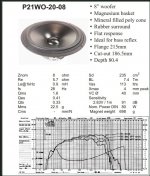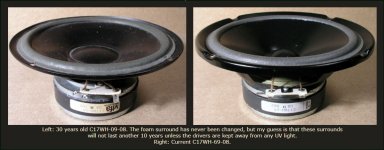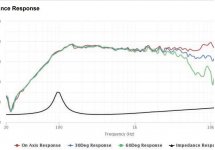Not as bad on some as you may imagine and higher than any frequencies that would be involved in any BSC so irrelevant.
dave
dave
Samuelj, if you check out the graphs I posted earlier they are basically 8" ideal fullrange drivers on a baffle and there is also the driver beaming visible which happens above frequencies of the bafflestep. Easily seen on the polar graph, or how the power response goes down as frequency goes up while axial response stays flat. First there is the diffraction hump, where the wavelenght is short enough for baffle to support it and diffraction happen but bigger than the transducer and not much narrowing happens yet. Above 1kHz the response starts to narrow because wavelenght shortens toward the driver diameter. Ever shorter wavelenghts driver starts to beam and less sound goes towards the baffle edge, diffraction disappears and less and less sound goes back of the enclosure. All of it happens in sequence from low frequencies up due to sound wavelenght shortens as frequency goes up and it all is relative to baffle size and transducer size.
Narrowing happens because the sound wave starts all around the transducer which interact with each other causing cancellation to various angles and strong constructive interference exactly on-axis. To understand how the narrowing happens you could imagine simplified situation of two small pointsources at opposite sides of the driver cone emitting sound and calculate their interaction to various angles at various frequencies. There is just infinite many such pointsources on the cone. In reality the cone is not piston but has all kinds of resonances where parts of the cone can move in opposite directions and have all sorts of distortions going on emitting some frequency at different phase at different locations on the cone. As I have understood this is actually how a direct radiating fullrange driver attempts to widen its response on short waveleghts, shorter than the diameter, by "controlled" breakup where for example center of the cone moves rather independently of rest of the cone on high frequencies making "smaller transducer" for highs, which can have wider response than the whole cone would have, beams only on shorter frequencies than the diameter of the center.
If you try to imagine the situation thinking wavelenght and how it all relates to baffle size and transducer size you'll come to conclusion this is all that happens because of the transducer size alone is minimum baffle, which is about ransducer diameter. Hence bafflestep / diffraction / beaming always happens and in this sequence.
Bafflestep and diffraction would disappear with infinite (not infinite but relative to wavelenght) baffle but a transducer always narrows its response on high frequencies. Transducer narrowing we can fight by crossing over to various sized transducers before this happens, or we can try and control the narrowing, controlled directivity.
Basically all acoustic stuff revolves around wavelenght and are not too hard to imagine 😉 sound reflects, transmits, diffracts, superimposes, nothing too hard, no rocket science. Many concepts can be imagined never checking the math behind or stuff at microlevel detail, through the wavelength thinking. It is not something too accurate and can be false of course, but helps to think and understand various phenomena how they might play out. For example all the bafflestep stuff on my posts. Besides, there is always something that even the simulators fail to catch, be it humidity or any other real world variable at play not implemented in the sim. Playing with all kinds of simulators help with the imagination a lot and eventually imagined ideas can be simulated to get more accurate answers.
Narrowing happens because the sound wave starts all around the transducer which interact with each other causing cancellation to various angles and strong constructive interference exactly on-axis. To understand how the narrowing happens you could imagine simplified situation of two small pointsources at opposite sides of the driver cone emitting sound and calculate their interaction to various angles at various frequencies. There is just infinite many such pointsources on the cone. In reality the cone is not piston but has all kinds of resonances where parts of the cone can move in opposite directions and have all sorts of distortions going on emitting some frequency at different phase at different locations on the cone. As I have understood this is actually how a direct radiating fullrange driver attempts to widen its response on short waveleghts, shorter than the diameter, by "controlled" breakup where for example center of the cone moves rather independently of rest of the cone on high frequencies making "smaller transducer" for highs, which can have wider response than the whole cone would have, beams only on shorter frequencies than the diameter of the center.
If you try to imagine the situation thinking wavelenght and how it all relates to baffle size and transducer size you'll come to conclusion this is all that happens because of the transducer size alone is minimum baffle, which is about ransducer diameter. Hence bafflestep / diffraction / beaming always happens and in this sequence.
Bafflestep and diffraction would disappear with infinite (not infinite but relative to wavelenght) baffle but a transducer always narrows its response on high frequencies. Transducer narrowing we can fight by crossing over to various sized transducers before this happens, or we can try and control the narrowing, controlled directivity.
Basically all acoustic stuff revolves around wavelenght and are not too hard to imagine 😉 sound reflects, transmits, diffracts, superimposes, nothing too hard, no rocket science. Many concepts can be imagined never checking the math behind or stuff at microlevel detail, through the wavelength thinking. It is not something too accurate and can be false of course, but helps to think and understand various phenomena how they might play out. For example all the bafflestep stuff on my posts. Besides, there is always something that even the simulators fail to catch, be it humidity or any other real world variable at play not implemented in the sim. Playing with all kinds of simulators help with the imagination a lot and eventually imagined ideas can be simulated to get more accurate answers.
Last edited:
Wavelength has to be considered in almost every design decisionBasically all acoustic stuff revolves around wavelength
dave
The flater the driver is the more you often need to push it down. I need -5.9dB Q0.5 on my Wifa they almost need baffle step compensation without the baffle LOL.
Aww ***** the last paragraph is a mess, edit time over. Anyway, for some reason I started to rambling about the imagination and trying to promote how the bafflestep among with many other phenomena are quite simple to understand at high (rough) level with just by thinking about the wavelength and how it relates with the physical object at hand. Simulators are great to help with this, one can choose dimensions to wavelengths and test if thinking is correct and how the stuff works out. Anyway, I find the imagination part a lot of fun and I hope this long late night text wasn't for nothing 😀 Carry on
Last edited by a moderator:
You mean 'Vifa'?I need -5.9dB Q0.5 on my Wifa they almost need baffle step compensation without the baffle LOL.
Which model are you referring to?
Samuel yes Vifa, P21WO 20-08. Works great with vented box.
Image from Troels on two smaller ones, old drivers were more flat and they often need more baffle step damping, maybe they changed the angle of the cone to get the break up under control?
Image from Troels on two smaller ones, old drivers were more flat and they often need more baffle step damping, maybe they changed the angle of the cone to get the break up under control?
Attachments
A ~related comparison of a 'shallow' Vs 'deep' cone 15" polars [pg. 5]:maybe they changed the angle of the cone to get the break up under control?
Attachments
This poll show there is a clear preference for 3dB and 6dB BSC.
I checked all anechoic loudspeaker measurements in soundstage.com and almost all of them have around 6dB BSC.
Just a couple of speakers having around 4dB BSC. Only exception is the Wilson Duette designed for near wall placement ( 5dB BSC implemented apparently).
So, all these DIY people who designs their own around 3dB BSC; won't they be living in compromise if they just go buy a commercially available speaker?
I checked all anechoic loudspeaker measurements in soundstage.com and almost all of them have around 6dB BSC.
Just a couple of speakers having around 4dB BSC. Only exception is the Wilson Duette designed for near wall placement ( 5dB BSC implemented apparently).
So, all these DIY people who designs their own around 3dB BSC; won't they be living in compromise if they just go buy a commercially available speaker?
on my avatar (now) I use about 3db, it is 9" wide, close to a wall, but the driver even on an infinite baffle rolls off at 150hz anyway.
But voices are "thin" without it.
but my opinion is skewed, even a flat speaker I would eq the response to look like a smiley face !!!!!!!!!!!!!!
But voices are "thin" without it.
but my opinion is skewed, even a flat speaker I would eq the response to look like a smiley face !!!!!!!!!!!!!!
Attachments
Historically, decent consumer speakers come with suggested speaker positioning instructions well away from a wall, corner, so will need it.So, all these DIY people who designs their own around 3dB BSC; won't they be living in compromise if they just go buy a commercially available speaker?
Yes, but a lot of people do not have that space in their room. So, they have very limited choice and live in compromise anyway, even if that is not the manufacturer's intent.Historically, decent consumer speakers come with suggested speaker positioning instructions well away from a wall, corner, so will need it.
OK, so maybe they like the extra bass and/or their preferred recordings aren't bass heavy or [the list goes on........]. 😉
- Home
- Loudspeakers
- Multi-Way
- Baffle step compensation sizing


